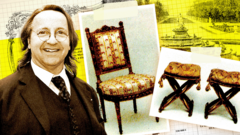The saga began in the early 2010s when two ornate chairs allegedly linked to Marie Antoinette surfaced on the antique market, captivating buyers and experts alike. Bearing the emblem of Nicolas-Quinibert Foliot, a renowned 18th-century cabinetmaker, these chairs were quickly labeled "national treasures" by French authorities. However, despite Versailles expressing interest, they were sold to Qatari Prince Mohammed bin Hamad Al Thani for a staggering €2 million (£1.67 million).
The deception deepened as a plethora of 18th-century royal furniture flooded the market, with several items acquired by Versailles for its vast museum collection. By 2016, this trove of charming royal chairs linked to figures such as Madame du Barry and Princess Élisabeth led to a comprehensive investigation that uncovered the truth: all these prized pieces were forged.
The investigation revealed Pallot, a respected antiques expert, and Desnoues, a decorated cabinetmaker, had masterminded this fraud. What began as a playful challenge to replicate an armchair from their workshop escalated into the creation of numerous convincing fakes that evaded scrutiny.
Both men admitted to their misconduct during court proceedings, stating they never intended to deceive and merely sought to test their skills. They procured wood cheaply, created the finishing touches themselves and embedded counterfeit stamps to mimic authentic pieces. Their effort reportedly netted them an estimated €3 million—a fortune they funneled into foreign bank accounts.
The scandal cast doubt on the reputation of reputable players in the art and antique trade. Laurent Kraemer, of the esteemed Galerie Kraemer, along with his gallery, faced accusations of gross negligence after unknowingly facilitating the sale of these forgeries to collectors and institutions. Kraemer's defense team argued that their client was also a victim of these skilled forgers.
Prosecutors have emphasized the dire need for better regulation in the antiquities market. The trial illuminated the essential standards that dealers must uphold to preserve trust and authenticity in the sale of historical items. The court also heard of the extravagant lifestyle of a middleman involved, which triggered scrutiny by authorities and led to the unraveling of this intricate web of deceit.
The fallout from this fraud has not only injured the reputations of those directly involved but has profoundly impacted the French antiques scene at large. With the verdict still pending, the art and antique world keeps a close watch on this unfolding scandal with implications that could ripple far beyond the courtroom.
The troubling events at Versailles serve as a stark reminder of the vulnerabilities within the world of art and antiquities, highlighting the fine line between authenticity and deception.
The deception deepened as a plethora of 18th-century royal furniture flooded the market, with several items acquired by Versailles for its vast museum collection. By 2016, this trove of charming royal chairs linked to figures such as Madame du Barry and Princess Élisabeth led to a comprehensive investigation that uncovered the truth: all these prized pieces were forged.
The investigation revealed Pallot, a respected antiques expert, and Desnoues, a decorated cabinetmaker, had masterminded this fraud. What began as a playful challenge to replicate an armchair from their workshop escalated into the creation of numerous convincing fakes that evaded scrutiny.
Both men admitted to their misconduct during court proceedings, stating they never intended to deceive and merely sought to test their skills. They procured wood cheaply, created the finishing touches themselves and embedded counterfeit stamps to mimic authentic pieces. Their effort reportedly netted them an estimated €3 million—a fortune they funneled into foreign bank accounts.
The scandal cast doubt on the reputation of reputable players in the art and antique trade. Laurent Kraemer, of the esteemed Galerie Kraemer, along with his gallery, faced accusations of gross negligence after unknowingly facilitating the sale of these forgeries to collectors and institutions. Kraemer's defense team argued that their client was also a victim of these skilled forgers.
Prosecutors have emphasized the dire need for better regulation in the antiquities market. The trial illuminated the essential standards that dealers must uphold to preserve trust and authenticity in the sale of historical items. The court also heard of the extravagant lifestyle of a middleman involved, which triggered scrutiny by authorities and led to the unraveling of this intricate web of deceit.
The fallout from this fraud has not only injured the reputations of those directly involved but has profoundly impacted the French antiques scene at large. With the verdict still pending, the art and antique world keeps a close watch on this unfolding scandal with implications that could ripple far beyond the courtroom.
The troubling events at Versailles serve as a stark reminder of the vulnerabilities within the world of art and antiquities, highlighting the fine line between authenticity and deception.



















